Rare photos of the past from a Scottish artist
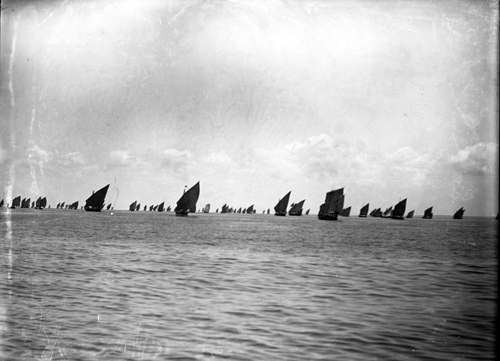
The boats setting out: A voyage of 20 miles from the shore
‘A Scottish Artist in Ceylon’ – a new exhibition this week at the Harold Peiris Gallery of the Lionel Wendt takes the visitor back more than a century to vanished views of the country, thanks to a collaboration between two National Trusts – of Scotland and Sri Lanka.
The year is 1907. A well-known Scottish artist Edward Atkinson Hornel arrives in Sri Lanka accompanied by his sister Elizabeth. Hornel is on a photographic mission: he visits the famous pearl fisheries on the island’s north western coast and it is presumed that with the help of his cousin James Hornell, he captures comprehensively the entire sequence of how that fraught operation unfolded.
A.E. Hornel also visited the tea plantations and his striking images of the tea pluckers are revealing of the difficult conditions under which they toiled.
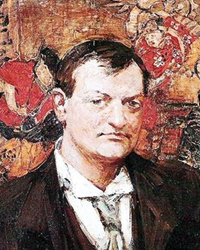
Edward Atkinson Hornel
In all, Hornel is believed have taken around 200 images in Sri Lanka and these repose with the Scottish National Trust which is the custodian of A.E. Hornel’s home Broughton House and studio.
“The collaboration has enabled the National Trust Sri Lanka to access and share this rich and unique visual archive. And National Trust for Scotland curators, who care for the artist’s studio, have hugely improved their understanding of the content of these images,” the International National Trusts Organisation (INTO) said in a statement.
Art historian, artist and architect Ismeth Raheem who curates the exhibition explains that the idea for an exhibition of Hornel’s photographs of early 20th century life in Sri Lanka was born through the links that trustee of the National Trust Sri Lanka, architect Pali Wijeratne has with the INTO and following a 2020 exhibition ‘E. A. Hornel: From Camera to Canvas’ in Edinburgh organised by the National Trust of Scotland that examined how photography influenced Hornel’s painting process.
The Hornel collection including the photographs taken in Sri Lanka were in the archive of Hornel’s house, along with others documenting the artist’s small town of Kirkcudbright and his travels around the globe.
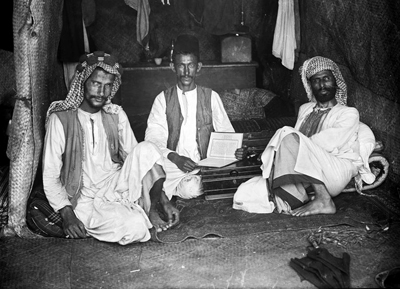
Shark soothers: Settled in their tent
Known for his richly detailed paintings of girls in romantic woodland settings and for his portraits, A. E. Hornel was one of the most commercially successful of Scottish painters. Born in Australia in 1864, his family returned to their hometown of Kirkcudbright when Hornel was young. He went on to study painting at the Trustees’ Academy, Edinburgh, from 1880 to 1883, and then at Antwerp Academy. Returning to Kirkcudbright in 1885, he worked closely with George Henry, one of the group of young painters known as the Glasgow Boys and the duo spent 18 months in 1894–95 in Japan where they immersed themselves in Japanese art and culture.
So why the interest in a visiting painter’s foray into photography? Raheem believes Hornel’s work provides some rare insights into an enterprise that was conducted on a truly international scale. Attracting those not just from the island, but also from neighbouring India (Gujarat and the south), Afghanistan and even Arabs from Bahrain, Qatar and Aden. If under the Portuguese,the pearl fishery was conducted in a rather disorganised manner and only slightly improved on by the Dutch, it was during British times that it became a well planned effort where the official operations was even advertised in other countries. French composer Georges Bizet’s 1863 opera ‘The Pearl Fishers’ however brought it to a wider audience.
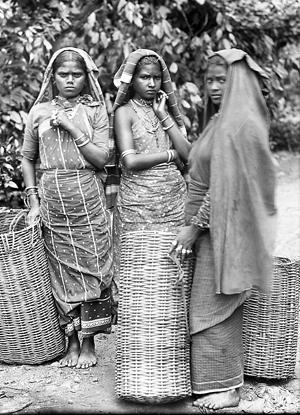
Tea pluckers: A trio of young women looking intently at the camera
While the exact duration of A.E. Hornel’s stay in the country is not known, Raheem’s carefully compiled and informative catalogue that accompanies the exhibition details that James Hornell spent years studying the marine fauna off the west coast, called in by Prof. W.A. Herdman who had been commissioned by Governor West Ridgeway to ascertain why the pearl fishery on the island had yielded disappointing results. His cousin, no doubt, contributed to the images,18 of which appear in this exhibition depicting the sequence of events from the arrival of the divers to the makeshift camps set up for some 20-30,000 for as long as three months. The catalogue provides fascinating insights into how the entire operation took place, even how ‘shark charmers’ were brought along with the divers from the Arab countries to give protection against deadly attacks.
Hornel’s images also show that the sailing craft that took part in the trawling came from various parts of the coastal district from North Ceylon, Western India and the present Gulf states, particularly Bahrain and Qatar.
The catalogue also notes that when Hornel and his sister came to Ceylon, photographic activity was well developed and Raheem believes that the images, around 40 of which he has chosen for this exhibition were taken using the dry plate technique.
In addition to visiting Sri Lanka, Hornel also travelled to Myanmar and there too photographed many subjects, his photography providing a valuable resource for his paintings.
‘A Scottish Artist in Ceylon’ is on at the Harold Peiris Gallery from January 13 -16 from 10 a.m. to 6 p.m.
The exhibition is funded by both the National Trusts of Scotland and Sri Lanka.
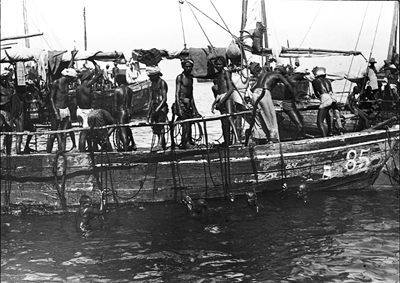
Ready for the dive: Divers by the boat hooked on to ropes
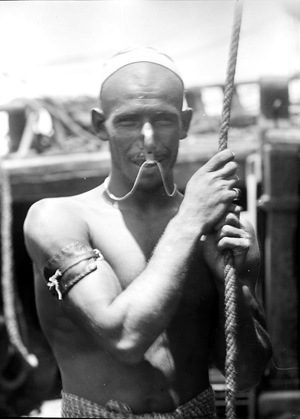
Arab diver: identifiable by his nose clip
Searching for an ideal partner? Find your soul mate on Hitad.lk, Sri Lanka's favourite marriage proposals page. With Hitad.lk matrimonial advertisements you have access to thousands of ads from potential suitors who are looking for someone just like you.


